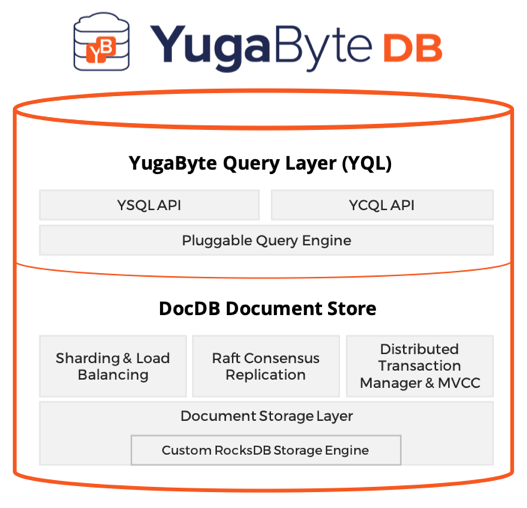Layered architecture
YugabyteDB architecture follows a layered design. It is comprised of 2 logical layers as shown in the diagram below:
- Yugabyte Query Layer
- DocDB distributed document store

Yugabyte Query Layer
The Yugabyte Query Layer or YQL is the upper layer of YugabyteDB. Applications interact directly with YQL using client drivers. This layer deals with the API specific aspects such as query/command compilation and the run-time (data type representations, built-in operations and more). YQL is built with extensibility in mind, and allows for new APIs to be added.
Currently, YQL supports two flavors of distributed SQL APIs.
Yugabyte SQL (YSQL)
YSQL is a distributed SQL API that is built by re-using the PostgreSQL language layer code. It is a stateless SQL query engine that is wire-format compatible with PostgreSQL.
Yugabyte Cloud QL (YCQL)
YCQL is a semi-relational language that has its roots in Cassandra Query Language. It is a SQL-like language built specifically to be aware of clustering of data across nodes.
Read More
Understanding the design of the query layer.DocDB
DocDB is a distributed document store. It has the following properties:
- Strong write consistency
- Extremely resilient to failures
- Automatic sharding and load balancing
- Zone/region/cloud aware data placement policies
- Tunable read consistency
Data in DocDB is stored in tables. Each table is composed of rows, each row contains a key and a document. Here are some key points:
Sharding
Data is stored inside tables in DocDB. A DocDB table is often sharded into a number of tablets. This sharding of tables is transparent to users.
You can read more about how sharding works in DocDB.
Replication
Each tablet consisting of user data is replicated according to some replication factor using the Raft consensus algorithm. Replication is performed at a tablet level, and ensures single row linearizability even in the presence of failures.
You can read more about how replication works in DocDB.
Persistence
In order to persist data, a log-structured row/document-oriented storage is used. It includes several optimizations for handling ever-growing datasets efficiently.
You can read more about how persistence of data works in DocDB.
Transactions
DocDB has support for both single-row and multi-row transactions. This means that DocDB allows modifying multiple keys while preserving ACID properties.
- Read about the isolation levels supported in DocDB.
- Single-row transactions.
- Multi-row transactions.
What's next
You can now read about the following: